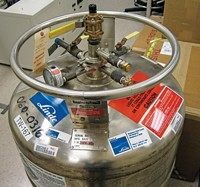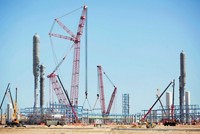Advertisement
Grab your lab coat. Let's get started
Welcome!
Welcome!
Create an account below to get 6 C&EN articles per month, receive newsletters and more - all free.
It seems this is your first time logging in online. Please enter the following information to continue.
As an ACS member you automatically get access to this site. All we need is few more details to create your reading experience.
Not you? Sign in with a different account.
Not you? Sign in with a different account.
ERROR 1
ERROR 1
ERROR 2
ERROR 2
ERROR 2
ERROR 2
ERROR 2
Password and Confirm password must match.
If you have an ACS member number, please enter it here so we can link this account to your membership. (optional)
ERROR 2
ACS values your privacy. By submitting your information, you are gaining access to C&EN and subscribing to our weekly newsletter. We use the information you provide to make your reading experience better, and we will never sell your data to third party members.
ACS News
Helium Price Spikes Are Hurting Academic Labs, Researchers Tell Congress
Critical Materials: University scientists worry about getting priced out of the market
by Cheryl Hogue
July 9, 2015
| A version of this story appeared in
Volume 93, Issue 28

Price spikes for liquid helium are hitting academic laboratories hard, William P. Halperin, a physics professor at Northwestern University, told a House of Representatives panel last week. Halperin is also chair-elect of the Condensed Matter Physics Division at the American Physical Society (APS).
“As the price has gone up, we have been forced to choose between abandoning a research project or laying off employees and students,” Halperin told the House Natural Resources Subcommittee on Energy & Mineral Resources. Helium is used to chill lab equipment such as the large magnets in some nuclear magnetic resonance instruments.
“The danger of price fluctuations or instability in a commodity as crucial as helium is that academic users would be priced out first,” Ryan C. Davison, the American Chemical Society’s manager for advocacy, told C&EN after the hearing. “Regardless of the expense, those in the chemical and pharmaceutical industries will find a way to purchase helium.”
Because of a supply shortage, academic chemistry and physics labs struggled for years to obtain liquid helium. But commercial supplies of helium started to increase in the past two years in part because Congress decided to keep open the Federal Helium Reserve in Texas. The reserve had been slated to close in 2013 until Congress intervened and set closure of the facility to 2021. Meanwhile, the government is selling off its helium supply.
Halperin told lawmakers that with the helium reserve set to close in six years, academic scientists worry that helium prices will rise to “unmanageable levels.” The benefits of keeping the reserve open beyond 2021 “could be immeasurable” to the research community, he said.
Meanwhile, ACS, which publishes C&EN, and APS have created a buying cooperative for liquid helium that now includes seven universities. The Defense Logistics Agency serves as a broker for the group of research labs, negotiating price and delivery terms with suppliers. Participants in the program this year saved an average of 15% on helium purchases compared with previous years, Halperin told lawmakers.
ACS, APS, and the Materials Research Society are also studying ways to transition academic labs to cooling systems that capture and recycle helium that leaks from instruments. Such recycling reduces needed supplies of liquid helium and can offset the cost of recycling equipment in three years, according to Halperin.




Join the conversation
Contact the reporter
Submit a Letter to the Editor for publication
Engage with us on Twitter